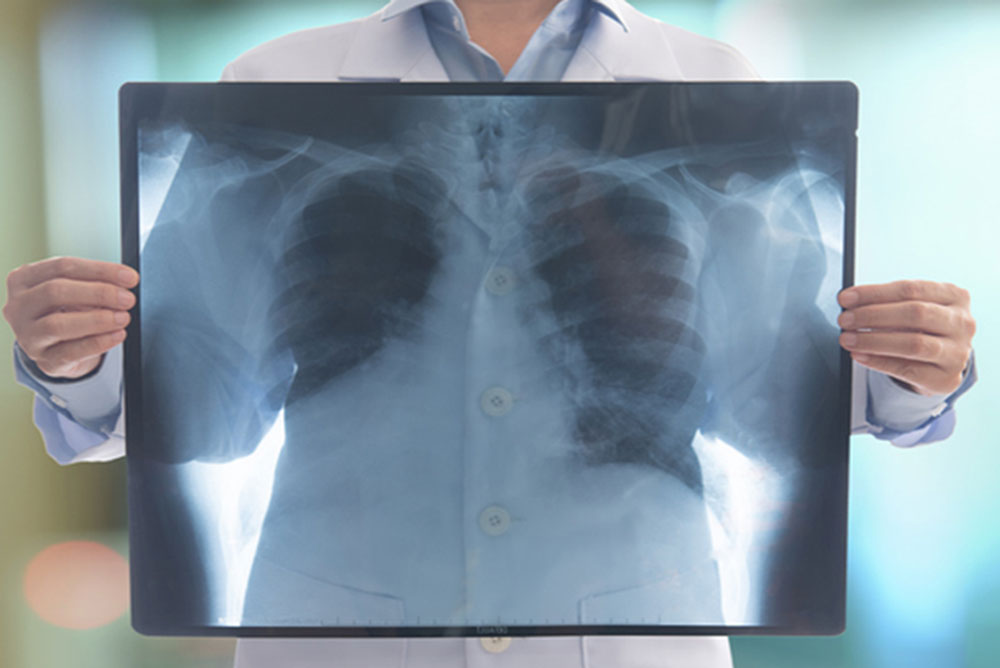
iStock
RESPIRATORY VIRUSES, like seasonal flu and coronaviruses, cause symptoms that begin “mild” and can progress to “moderate” or “severe”—most commonly in those over 60 and those with underlying health issues.
Even people with “mild to moderate” respiratory symptoms can develop pneumonia, infections traced to viruses or bacteria that cause air sacs in the lungs to fill with fluid or pus. Infants younger than two and people over 65 are at higher risk because their immune systems aren’t as strong.
An overly active immune response, on the other hand, can lead to severe inflammation that destroys lung tissue and limits oxygen—and can lead to a dangerous cycle of more inflammation, less oxygen reaching the organs, organ failure and death.
For Covid-19–the d refers to disease—“moderate” symptoms can include a dry cough, fever above 100.4, chills and fatigue. These symptoms can be reason for hospitalization when accompanied by dehydration or difficulty drawing a breath.
Shortness of breath that can develop with Covid-19 also occurs in a “wide spectrum” of severity depending on the related activity, explains Montefiore Health System epidemiologist Theresa Madaline: from climbing stairs to no activity at all, like sitting in a chair.
With confirmed or suspected Covid-19, shortness of breath is a “symptom to always check with a health care provider. Period,” according to pulmonologist Kenneth Lyn-Kew at Denver’s National Jewish Health. “Because shortness of breath can mean low oxygen levels in the blood.”
When insufficient oxygen is getting to the body’s organs, a breathing machine—respirator or ventilator—may be necessary to prevent multi-system failure leading to organ shutdown and death.
To test for pneumonia, a “pulse-ox” (pulse oximeter) finger clip can measure the percent of oxygen in red blood cells, which should be at or greater than 95%. Also, blood testing can reveal the presence of bacteria. But the chest x-ray is the definitive test for pneumonia.
When a respiratory virus enters the body through the nose or throat, symptoms often include a sore throat or cough. The viral particles can keep moving down the bronchial tubes and into the lungs, particularly when the immune system is weak due to underlying conditions, such as diabetes, heart disease and obesity.
Weakened immunity can also be traced to other illnesses, including severe seasonal flu or the common cold, which leave the airways raw and inflamed and more vulnerable to viruses as well as to bacteria—which can cause sinus infections and bronchitis.
When viral particles reach the lungs, inflamed mucous membranes make it more difficult for the alveoli, or lung sacs, to supply oxygen and remove carbon dioxide from the blood. Infection can continue spreading downward through the gastrointestinal tract to the rectum; can enter the bloodstream and move throughout the body; and can directly attack organs including the heart, kidney and liver.
High fever in someone who has been sick can signal an overactive immune response, also called a cytokine storm—referring to immune cells called cytokines that normally protect the lungs—that can be deadly if untreated. Specific tests and treatment of out-of-control immune reactions may have helped cure some Covid-19 pneumonia sufferers in China.
While researchers elsewhere are waiting for the Chinese to publish specific data on the patients and drugs involved, the World Health Organization has initiated a global trial called SOLIDARITY with plans to include thousands of sufferers. Among medications that showed good results in the very small numbers of Chinese patients, the antimalarial drugs hydroxychloroquine and chloroquine—which combat autoimmune reactions in people with lupus and rheumatoid arthritis—may control cytokine release syndrome in critically ill patients.
Excessive inflammation from an overactive immune system can travel throughout the body, in the worst cases leading to septic shock, with organ shutdown that can cause death. Even when patients seem to be stable or recovering, bacteria can attack already-damaged, vulnerable lung tissues, causing relapse and death.
While about 80% of people infected with the currently circulating novel coronavirus have mild symptoms, about 20% become more seriously ill and 3 to 5% will die. Besides strength of the person’s immune system, outcomes depend on underlying conditions and probably genetic makeup.
In Italy, among more than 2,000 deceased, women were less likely to die (601 cases) than men (1,402) and were older (average age 83.7) compared to men (79.5) (personal communication based on translation from the Italian newspaper La Repubblica).
Besides precautions like hand washing and social distancing to avoid getting sick, keep your immune system strong with diet and exercise— and don’t hesitate to call the doctor if you have symptoms, especially unusual shortness of breath.
—Mary Carpenter
Well-Being Editor Mary Carpenter is keeping her eye on the corona virus for us. For more of her posts, click here.

This is all pretty frightening. Thanks for a science-based column, instead of the nonsense being peddled by you-know-who.